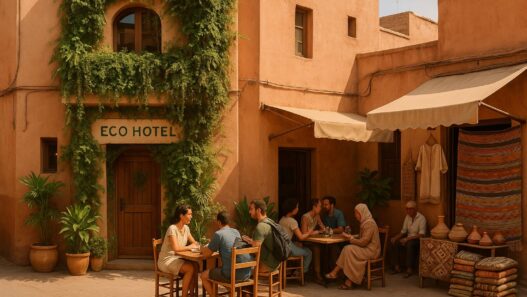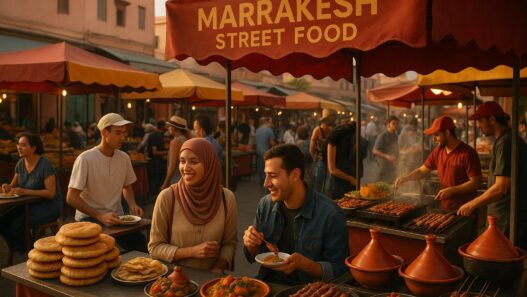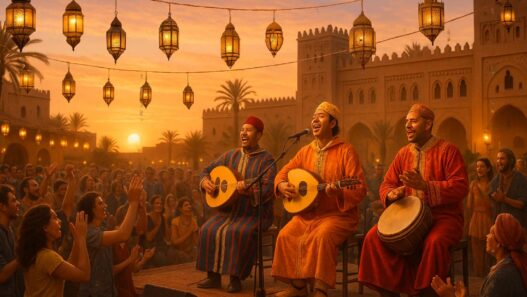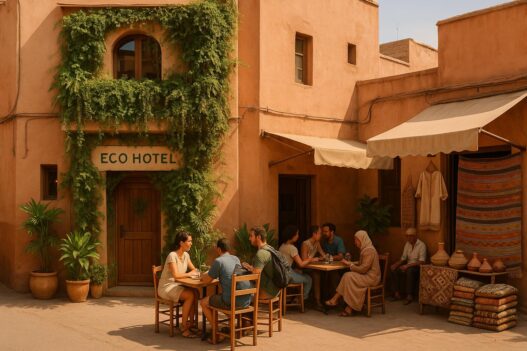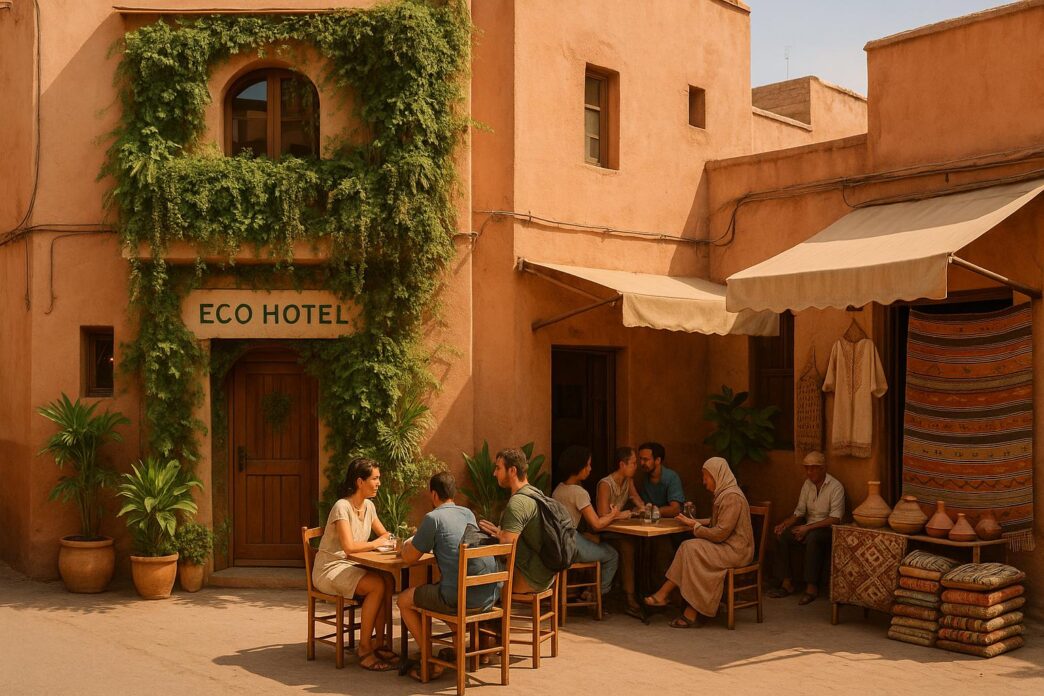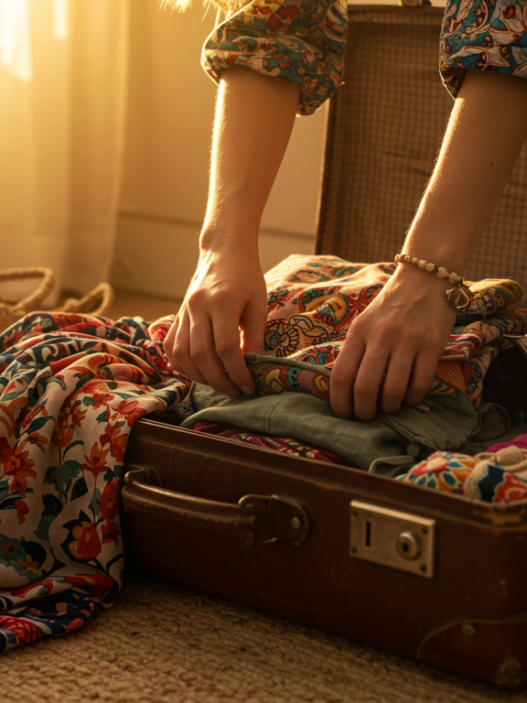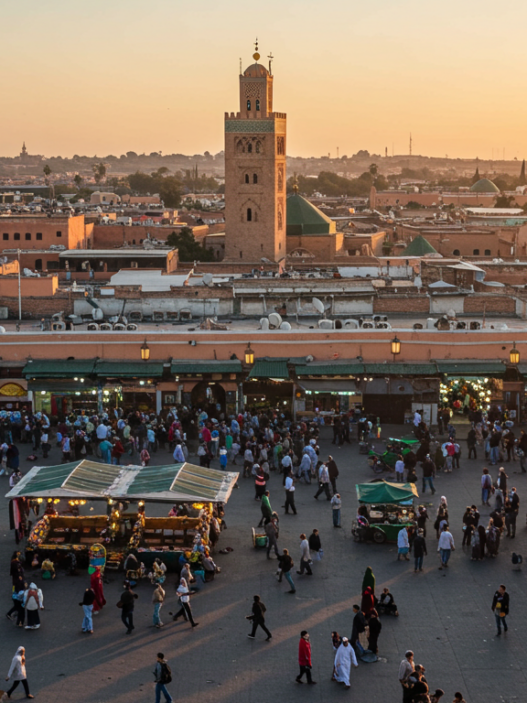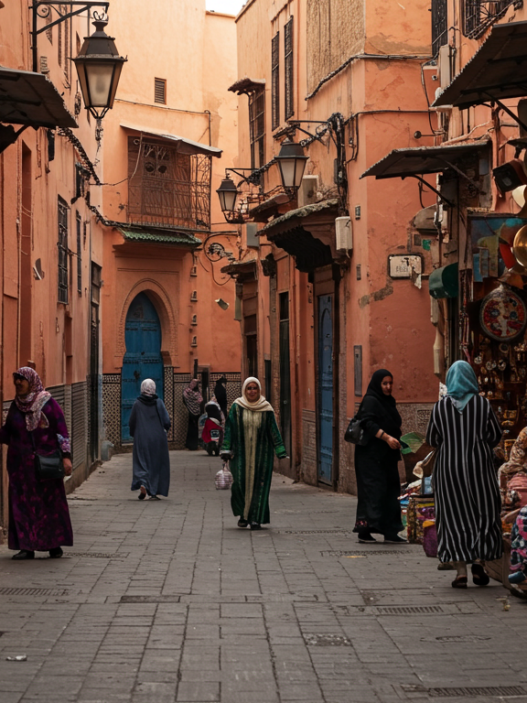Marrakesh is a vibrant destination that blends history with modern tourism. However, the city faces challenges like water scarcity, resource strain, and the preservation of its UNESCO-listed Medina. Travelers can make a positive impact by choosing eco-friendly options, supporting local businesses, and reducing their environmental footprint. Here’s how:
- Stay Green: Opt for riads or eco-lodges that use solar panels, recycle water, and source materials locally. Look for certifications like Green Key or Travelife to confirm their efforts.
- Move Smart: Use Marrakesh’s electric Bus Rapid Transit (BRT) system, walk, or cycle to explore the city while reducing emissions.
- Eat Wisely: Dine at restaurants using locally sourced ingredients or try plant-based Moroccan dishes like vegetable tagines and zaalouk.
- Shop Ethically: Buy handmade goods like Berber carpets and ceramics from artisans or fair-trade cooperatives to support local communities.
- Explore Responsibly: Join guided hikes, visit eco-friendly gardens, or stay in desert camps that minimize impact while educating visitors.
Morocco’s ecotourism push | Morocco embraces sustainable tourism | World Of Africa
Green Accommodations in Marrakesh
Choosing the right place to stay can make a big difference when it comes to traveling sustainably in Marrakesh. The city offers plenty of options for accommodations that focus on protecting the environment and supporting local communities. By being mindful of where you stay, you can reduce your carbon footprint and contribute to the well-being of Moroccan families.
Staying in Local Riads
Staying in a traditional riad is one of the best ways to support sustainability in Marrakesh. These charming, locally owned guesthouses not only reinvest profits into the community but also create jobs for local residents and source materials from nearby artisans. It’s a great way to make sure your travel spending benefits the people who call Marrakesh home.
Riads are restored using local materials and traditional techniques.
Beyond their community impact, riads are also environmentally friendly by design. Their thick walls and central courtyards naturally regulate indoor temperatures, cutting down on the need for energy-hungry air conditioning. Many riad owners work closely with local craftsmen to preserve authentic features like intricate tilework, carved wood, and traditional plaster designs.
Staying in a riad also offers a more personal touch. Hosts often provide insider tips on the best local spots, from hidden restaurants to artisan workshops, giving you a deeper connection to Marrakesh’s rich history and culture.
Prices for riads vary widely, ranging from $40 to $200+ per night depending on amenities and location. This makes them accessible to a variety of budgets while allowing you to directly support Moroccan families. Next, let’s explore how to ensure the property you choose is genuinely eco-friendly.
How to Find Certified Green Properties
Not all sustainability claims are created equal, so it’s important to dig a little deeper when evaluating a property’s environmental efforts.
Look for third-party certifications like Green Key, EarthCheck, or Travelife to confirm verified sustainability practices.
Pay close attention to the details on a property’s website. Genuine eco-friendly accommodations will highlight specific initiatives, such as using solar panels, installing water-saving fixtures, running recycling programs, or engaging in community projects. Vague claims without details should raise a red flag.
Don’t hesitate to ask questions directly. Inquire about their energy sources, water conservation efforts, waste management systems, and whether they source food and materials locally. Properties that are serious about sustainability will be transparent about their practices.
Eco-labels and certifications displayed on booking platforms or property websites can also be a helpful guide. Always verify these with the issuing organizations. Additionally, guest reviews can provide useful insights – look for mentions of features like solar-heated water, organic meals, or recycling facilities to gauge how well the property follows through on its sustainability promises.
Top Green Lodging Options in Marrakesh
Marrakesh is home to several accommodations known for their commitment to the environment and community.
Eco-lodges in the city’s oases often feature natural gardens that promote biodiversity and use eco-friendly gardening techniques.
These lodges typically employ efficient irrigation systems to conserve water while creating serene, green spaces for visitors.
Many properties with organic gardens offer farm-to-table dining experiences, showcasing seasonal Moroccan ingredients.
By partnering with local farms or maintaining their own gardens, these accommodations cut down on transportation emissions and serve fresh, flavorful meals.
Some eco-friendly hotels go a step further by offering educational programs. These might include lessons on local conservation efforts or workshops on Moroccan sustainability practices, giving guests a chance to learn while they relax.
| Accommodation Type | Sustainability Features | Price Range (USD/night) | Cultural Experience |
|---|---|---|---|
| Local Riads | Locally owned, traditional design, supports families | $40–$200+ | High |
| Eco-Lodges | Solar energy, water conservation, organic food | $80–$250+ | Moderate–High |
| Chain Hotels | Varies, often less sustainable | $100–$300+ | Low–Moderate |
For English-speaking travelers, The Marrakesher offers tailored guides and reviews to help identify sustainable accommodations in Marrakesh. Their July 2025 article, "How to Support Marrakesh’s Eco-Tourism Efforts," is packed with practical tips for finding eco-friendly properties and understanding their positive impact on local communities.
When booking your stay, aim for properties that actively invest in water conservation, renewable energy, and community support. These choices not only align with Marrakesh’s environmental goals but also provide a richer, more authentic travel experience.
Low-Impact Transportation in and Around Marrakesh
Traveling sustainably in Marrakesh doesn’t just help the environment – it also saves money and immerses you in the city’s vibrant culture. Whether you’re strolling through the historic medina, hopping on an electric bus, or cycling through the streets, Marrakesh offers plenty of options to explore while keeping your carbon footprint in check.
Walking and Cycling in Marrakesh
Exploring Marrakesh on foot is one of the simplest and most rewarding ways to experience the city. The narrow, winding streets of the medina are perfect for walking, offering a chance to stumble upon hidden gems that you’d miss in a car. Plus, walking is completely emission-free.
For those looking to cover more ground, cycling is a fantastic alternative. It’s becoming increasingly popular, with many guesthouses and rental shops offering bikes for around $5 to $15 per day. Not only is cycling affordable, but it’s also a much greener option compared to taxis or private cars.
To make the most of your walking or cycling adventures, wear sturdy shoes, stay hydrated, and, if biking, always use a helmet. Be cautious at busy intersections where motorbikes, cars, and pedestrians converge. If you’re cycling, stick to well-traveled routes until you’re familiar with the city’s layout, and avoid riding at night due to limited street lighting.
The medina’s bustling squares, such as Jemaa el-Fnaa and the surrounding souks, are ideal for walking. For cycling, it’s best to use it for connecting neighborhoods or reaching attractions outside the city walls. If you’re heading further afield, Marrakesh’s public transit system is a convenient and eco-friendly choice.
Using Public Transit and Shared Transport
Marrakesh has taken important steps toward greener public transportation, including the introduction of electric buses in 2017. These solar-powered buses are a key part of the city’s efforts to reduce urban emissions and improve transit options.
The city’s Bus Rapid Transit (BRT) system connects major neighborhoods with affordable fares, typically between $0.60 and $0.80 per ride. It serves over 45,000 passengers daily, helping reduce traffic congestion and emissions. Operated by ALSA Marrakesh, the system includes 45 bus lines that cover the city and nearby areas, making it easy to get around without a car.
Shared taxis are another practical option for sustainable travel. These taxis carry multiple passengers heading in the same direction, which reduces the environmental impact per person. They’re especially useful for trips to the airport or popular attractions. Ride-sharing apps also offer pooled rides, further cutting down on emissions.
| Transportation Mode | Emissions | Cost per Trip | Best For | Environmental Benefit |
|---|---|---|---|---|
| Electric Bus/BRT | Zero | $0.60–$0.80 | City travel | Eliminates air and noise pollution |
| Walking/Cycling | None | Free–$15/day | Short distances, medina | Zero carbon footprint |
| Shared Taxi | Moderate | $1–$2 | Flexible city travel | Reduces vehicles per passenger |
| Conventional Bus | Low | $0.60–$0.80 | City connections | Lower emissions than private cars |
Green Travel to Nearby Destinations
If you’re planning to explore beyond Marrakesh, there are plenty of sustainable ways to visit Morocco’s stunning natural landscapes. Group tours using minibuses or coaches are a great choice – they distribute emissions across multiple passengers, making them far more eco-friendly than private cars.
Companies like Morocco Green Tours specialize in eco-conscious travel, offering group trips to the Atlas Mountains and the Sahara Desert. These tours often include insights into local ecosystems and support for community-based tourism, making them a meaningful way to travel sustainably.
For destinations closer to Marrakesh, public buses provide a budget-friendly and lower-impact option for reaching nearby towns, including those near the Atlas Mountains. Group tours to these areas often start at around $40 per person, offering an affordable and greener alternative to renting a car.
When choosing a tour operator, prioritize those that use fuel-efficient vehicles, limit group sizes to reduce strain on sensitive areas, and contribute to conservation efforts. Skipping solo car rentals or private drivers can reduce your carbon footprint by up to 70%, making a big difference for the environment.
The Marrakesher is a helpful resource for finding updated guides on sustainable transportation and eco-friendly tour operators. It’s a great way to ensure your travels align with your environmental values while exploring the incredible landscapes of Morocco.
Responsible Dining: Supporting Local and Green Food
Your dining choices in Marrakesh can significantly impact the environment, just like your decisions about where to stay and how to travel. Opting for restaurants that prioritize local and sustainable ingredients not only means fresher meals but also supports Moroccan farmers and cuts down on your carbon footprint.
Choosing Locally Sourced Ingredients
Dining at establishments that use locally sourced ingredients helps reduce food transport emissions while directly supporting local farmers. It also ensures fresher, seasonal dishes and promotes biodiversity by encouraging the use of traditional crops.
Keep an eye out for restaurants that highlight their partnerships with local suppliers on their menus or display certifications for sustainable sourcing. Don’t hesitate to ask your server about the origins of the ingredients – many places are proud to share this information. The growing popularity of farm-to-table initiatives in Marrakesh makes it easier than ever to find eco-conscious dining options.
Marrakesh’s bustling markets, like those near Jemaa el-Fnaa and Marché Central, are treasure troves of fresh, local produce. Many environmentally aware restaurants source their ingredients directly from these markets, creating a direct line from farmer to table. Traditional Moroccan dishes, such as tagines and couscous, naturally align with sustainable dining principles, as they often feature locally grown vegetables, grains, and spices.
Dining responsibly doesn’t have to break the bank. A meal at a local, sustainable restaurant typically costs between $8 and $20 per person, making it an affordable way to contribute to greener practices. Additionally, exploring plant-based menus can elevate your dining experience while celebrating Morocco’s culinary traditions.
Finding Vegetarian and Vegan Options
Plant-based dining in Marrakesh has seen notable growth. According to a 2023 survey, over 40% of restaurants now offer at least one vegetarian or vegan dish[Morocco Tourism Board, 2023]. Popular options include vegetable tagine, zaalouk (a flavorful eggplant salad), lentil soup, and couscous with seasonal vegetables – all of which are delicious and often budget-friendly, with many dishes priced under $10.
Many riads and modern cafes now feature dedicated vegetarian menus inspired by traditional Moroccan recipes. To find these spots, use apps or websites that list vegetarian and vegan-friendly restaurants, or simply ask locals and hotel staff for recommendations. Exploring these plant-based options lets you enjoy Morocco’s rich culinary heritage while sticking to sustainable eating habits.
Street food is another fantastic way to experience plant-based dishes. Vendors often use minimal packaging and source their ingredients from nearby markets, ensuring both freshness and affordability. Meals from street vendors typically range from $2 to $8, making them a great choice for eco-conscious travelers.
| Dining Option | Local Sourcing | Plant-Based Choices | Food Waste Practices | Price Range (USD) |
|---|---|---|---|---|
| Traditional Restaurant | Moderate | Limited | Variable | $10–$25 |
| Eco-Certified Eatery | High | Extensive | Strict waste management | $8–$20 |
| Street Food Vendor | High | Some | Minimal packaging | $2–$8 |
Mindful dining doesn’t stop at ingredient sourcing – it also involves reducing food waste.
Reducing Food Waste While Traveling
Food waste is a pressing issue in Morocco, with up to 25% of all food produced going to waste, according to World Bank data from 2022. To combat this, the Moroccan government aims to cut food waste by 50% by 2030, aligning with global sustainability goals.
You can help by ordering portions that match your appetite and sharing dishes with your travel companions. Sharing isn’t just eco-friendly – it’s a cultural tradition in Morocco. Leftovers? Ask for them to be packed in reusable containers. Bringing your own container is an easy way to avoid single-use packaging.
Seek out restaurants that actively reduce waste through practices like composting or donating surplus food to local charities. Many hotels and eateries in Marrakesh have implemented programs to tackle food waste, including staff training and customer education campaigns. Local NGOs and cooperatives also play a role, redistributing surplus food to those in need and running workshops to raise awareness.
When ordering, ask about portion sizes – especially for traditional Moroccan meals, which are often designed for sharing. Restaurant staff can guide you on how much to order for your group, letting you sample more dishes while avoiding waste.
Choosing responsible dining options supports small-scale farmers, conserves resources, and reduces greenhouse gas emissions. As more people demand local and sustainable food, producers are encouraged to adopt eco-friendly practices, creating a ripple effect that benefits both the environment and the local economy.
For more tips and reviews on eco-friendly dining in Marrakesh, check out The Marrakesher.
Responsible Shopping: Supporting Local Artisans and Fair Trade
Shopping ethically plays a big role in sustainable travel when visiting Marrakesh. By making thoughtful choices, you can directly support local communities. Buying from local artisans and fair trade cooperatives not only helps preserve traditional crafts but also ensures families earn a fair wage. The key is knowing where to shop and what to look for. Let’s explore how purchasing handmade items can make a difference.
Buying Handmade and Locally Produced Goods
Marrakesh is renowned for its centuries-old artisan traditions, with countless workshops producing stunning crafts like zellige tilework, Berber carpets, and tadelakt plaster. When you choose handmade goods, your money stays within the local economy, helping to sustain these traditions.
The city’s vibrant souks, including Souk Semmarine and Souk Haddadine, are treasure troves of authentic handmade items. Here, you’ll find everything from handwoven textiles and brass lanterns to ceramics, leather goods, and argan oil products. Authenticity often reveals itself in small imperfections – those little quirks that highlight human craftsmanship. Don’t hesitate to ask vendors about the origins of a product or the artisan behind it to ensure you’re getting something genuine.
It’s worth noting that over 70% of souvenirs in tourist-heavy areas are mass-produced. Authentic handmade goods tend to be priced according to the skill and time invested: Berber carpets range from $150 to $1,500, hand-painted ceramics from $10 to $50, and leather items like bags or traditional slippers typically cost between $25 and $200.
When shopping, engage with artisans respectfully. Show interest in their craft and ask about their techniques or materials. While bargaining is customary, keep in mind the effort and artistry that go into these creations.
Shopping at Fair Trade Cooperatives
Fair trade cooperatives provide an excellent way to support local artisans while ensuring they receive fair wages and work in safe conditions. These cooperatives often reinvest in their communities through various programs. For example, the government-backed Ensemble Artisanal is a great place to start your fair trade shopping journey. Other notable cooperatives include Al Nour, which supports women with disabilities, and Tameslouht Cooperative, celebrated for its exquisite textiles and weaving.
Between 2019 and 2023, fair trade networks in Morocco have boosted artisan incomes by 30–40%. Many of these cooperatives employ women and marginalized groups, providing them with stable income and opportunities for empowerment. Visitors often appreciate the unique designs, direct interactions with artisans, and transparency about sourcing. While prices might be higher compared to mass-produced items, many travelers find comfort in knowing their purchases contribute to a positive cause. Most cooperatives accept credit cards and U.S. dollars, and many even offer shipping services for larger items like carpets.
To shop ethically, avoid overloading on souvenirs and focus on quality over quantity.
Avoiding Over-Consumption and Mass-Produced Souvenirs
Choosing fewer, high-quality items that hold personal meaning or practical value is a more mindful approach to shopping. This not only reduces waste but also ensures your money goes toward supporting local artisans rather than overseas manufacturers.
Mass-produced souvenirs are easy to spot – they’re often uniform, sold in bulk at tourist stalls, and sometimes even carry “Made in China” labels. These items do little to benefit local communities and contribute to environmental waste through unnecessary production and shipping.
| Item Type | Handmade/Local Price | Mass-Produced Price | Community Impact |
|---|---|---|---|
| Berber Carpets | $150–$1,500 | $50–$200 | Direct artisan support |
| Leather Slippers | $25–$60 | $10–$20 | Preserves traditional skills |
| Ceramics | $10–$50 | $5–$15 | Funds local workshops |
| Artisan Jewelry | $20–$200 | $5–$30 | Supports fair wages |
Before heading out to shop, set a budget and research the items you’re interested in. Consider prioritizing experiences – like visiting artisan workshops or learning about traditional crafts – over collecting a pile of souvenirs. When you do buy, choose items that carry lasting value, like a handwoven textile to decorate your home or jewelry you’ll actually wear.
For detailed recommendations on ethical shops and cooperatives, check out The Marrakesher, which offers guides tailored to English-speaking travelers looking for responsible shopping experiences in Marrakesh.
sbb-itb-fa26f1f
Activities That Respect Nature and Local Culture
Once you’ve chosen sustainable accommodations and embraced mindful spending, the next step in eco-friendly travel is immersing yourself in local activities. Opt for experiences that leave a light footprint while fostering genuine connections with the environment and community.
Nature-Based Tourism and Green Activities
Marrakesh offers a variety of ways to enjoy nature while supporting conservation efforts. For example, guided hikes in the Atlas Mountains not only treat you to breathtaking views but also educate you about the region’s ecosystems and wildlife preservation efforts. Similarly, birdwatching trips in the High Atlas foothills provide the chance to spot native species while learning about habitat protection.
The city’s sustainable gardens, such as Jardin Majorelle and Menara Gardens, demonstrate how tourism can promote environmental awareness. These gardens showcase water-saving techniques and the conservation of local plant species, offering practical ideas for eco-conscious gardening that visitors can bring home.
Nearby eco-lodges provide a deeper connection to the land and local traditions. Many of these lodges host workshops on organic farming, guided nature walks, and traditional cooking classes, giving visitors a hands-on experience with Marrakesh’s agricultural and culinary heritage.
For a desert adventure, consider staying at eco-friendly desert camps. These camps minimize their environmental impact while offering authentic experiences like traditional music, storytelling, and stargazing. They also focus on educating visitors about the challenges of desert conservation and the importance of protecting this fragile environment.
Local Guide Tours
Hiring a local guide can transform your trip into a meaningful cultural exchange. These guides share personal insights into Moroccan history, architecture, and traditions, offering stories and details you won’t find in guidebooks. Whether it’s learning the history behind a neighborhood or discovering family recipes, local guides add depth to your experience.
Moreover, choosing a local guide ensures your spending directly benefits Marrakesh’s communities. Many guides are artisans, storytellers, or historians who use their earnings to support their families and preserve traditional knowledge. This creates a ripple effect, supporting not just the guides but also local businesses like restaurants, transportation services, and craft workshops recommended during tours.
Community-led tourism has had a measurable impact, with some villages reporting a 20% increase in tourism-related jobs since adopting sustainable practices. Local guides also excel at preserving intangible heritage, such as storytelling and artisanal crafts. They often arrange visits to family-run workshops, invite guests to traditional meals, or share oral histories, creating genuine connections between visitors and residents.
For a unique perspective, Jewish Heritage tours led by local experts explore Marrakesh’s diverse cultural history. These tours highlight the significance of historical sites while supporting community preservation efforts.
Responsible Wildlife and Habitat Visits
When planning wildlife visits, it’s important to prioritize ethical and conservation-focused experiences. Always avoid activities that disturb ecosystems, such as those involving feeding or handling animals. Instead, choose tours that emphasize observation and education.
For example, guided tours of the Palmeraie oasis focus on teaching visitors about traditional irrigation systems and the delicate balance required to sustain these green spaces in a dry climate. These tours highlight Morocco’s water challenges while showcasing solutions that have worked for generations.
When exploring natural areas, stick to designated paths and follow local regulations. Many tour operators now provide pre-visit briefings to educate guests on wildlife behavior, migration patterns, and the importance of maintaining a respectful distance from animals.
Look for operators who prioritize education over entertainment. The most rewarding wildlife experiences combine observation with learning, helping visitors understand their role in protecting fragile ecosystems. Ethical operators often limit group sizes, use quiet transportation methods, and allocate part of their profits to conservation projects.
| Activity Type | Environmental Impact | Cultural Engagement | Community Benefit |
|---|---|---|---|
| Guided Nature Walks | Low | Moderate | High |
| Local Guide-Led City Tours | Low | High | High |
| Wildlife Habitat Visits | Varies (Ethical) | Low | Moderate |
| Mass-Market Excursions | High | Low | Low |
For curated recommendations on eco-friendly activities, check out The Marrakesher. Their locally sourced guides ensure your choices align with principles of responsible tourism while helping you connect meaningfully with Morocco’s natural and cultural treasures.
Practical Tips for Reducing Waste and Conserving Resources
Sustainable travel isn’t just about the journey – it’s about the small, everyday actions that help protect Marrakesh’s limited resources. With tourism and an arid climate putting strain on the city’s natural reserves, every effort matters.
Using Reusable Items
One of the easiest ways to cut down on waste is by swapping single-use items for reusable ones. Pack essentials like a stainless steel or BPA-free water bottle, collapsible shopping bags, reusable utensils, and a travel coffee cup. If you didn’t bring these items, no worries – local markets in Gueliz often stock them. Plus, many riads and eco-lodges either provide or sell these items to guests, making it simple to adopt eco-friendly habits once you’re there.
When shopping in Marrakesh’s vibrant souks, bring your own reusable bags and kindly decline plastic ones. Similarly, when dining out, skip the plastic straws and cutlery by using your own. These small changes add up and help reduce the city’s plastic waste problem.
Conserving Water and Energy
In Marrakesh’s dry climate, water conservation is especially critical, particularly during the scorching summer months. Simple actions like taking shorter showers, turning off taps while brushing your teeth, and reusing towels can make a big difference. Many eco-friendly accommodations support these efforts by installing water-saving devices and encouraging guests to participate.
Energy conservation is just as vital. Switch off lights, air conditioning, and electronics when they’re not in use. Whenever possible, rely on natural ventilation instead of air conditioning. Morocco is making strides in renewable energy with solar and wind projects that are among the largest in Africa. Staying in accommodations that use solar panels or other renewable energy sources can reduce your environmental footprint. Walking or cycling instead of using motorized transport not only saves energy but also lets you experience the city in a more authentic way.
Proper Waste Disposal and Recycling
Managing waste responsibly is another key part of sustainable travel. Marrakesh’s waste management system is improving, but recycling facilities are still limited compared to what you might find in the U.S.. Separate recyclables like plastic bottles and cans, and check with your accommodation about recycling options. Carry a small bag for trash so you can dispose of it properly in designated bins.
Since composting isn’t widely available, aim to minimize food waste. Order only what you can finish, and share dishes when dining out. If you have leftovers, use reusable containers to store them. Some eco-conscious restaurants and riads compost food scraps or donate excess food to local charities – ask about these practices and participate when you can.
Local organizations like Morocco Green Tours and community-led clean-up groups work to reduce waste and promote environmental awareness. Some eco-lodges and riads collaborate with these groups, offering guests opportunities to join clean-up days or attend workshops on sustainable living. These activities not only support conservation efforts but also provide a hands-on way to engage with the community.
For up-to-date information on Marrakesh’s sustainability initiatives and waste management options, check out The Marrakesher. Their guides are tailored for English-speaking travelers and regularly updated to reflect the city’s evolving efforts.
Understanding Marrakesh’s Climate Challenges and Conservation Efforts
Marrakesh faces tough environmental challenges due to its dry climate, rapid urban growth, and the increasing number of tourists. These factors put significant pressure on local resources and ecosystems, making it essential for both residents and visitors to adopt more sustainable practices.
Water Scarcity and Conservation
The combination of Marrakesh’s semi-arid climate, expanding urban areas, and tourism boom has created a heavy demand on the region’s water supply. To tackle this, many hotels, riads, and restaurants have implemented water-saving strategies like recycling greywater, installing low-flow fixtures, and harvesting rainwater. They also encourage guests to conserve water by reusing towels and embrace landscaping with drought-resistant plants to minimize water use. These efforts are vital not just for the local population but also for maintaining the fragile ecosystems around the city.
Protecting Local Wildlife and Ecosystems
Water conservation plays a dual role – it supports human needs while also safeguarding the habitats of local wildlife. Marrakesh is surrounded by diverse ecosystems, including mountain ranges, wetlands, and semi-desert areas, all of which are increasingly vulnerable to climate change and urbanization. In the Atlas Mountains, for example, species like the Barbary macaques face habitat loss, while green spaces near the city serve as important resting spots for migratory birds such as the Northern Bald Ibis. Additionally, native plants, including argan trees, help prevent soil erosion and provide economic benefits through argan oil production. Conservation efforts in the region focus on restoring and protecting these habitats to ensure the survival of its unique biodiversity. Local communities have been actively involved in these initiatives, recognizing the importance of preserving their natural surroundings.
Local Organizations Making a Difference
Community-driven conservation efforts are gaining momentum across Marrakesh. Women-led argan oil cooperatives are promoting sustainable land use while also offering educational experiences that showcase traditional harvesting methods. Urban gardens like Jardin Majorelle and Menara Gardens demonstrate efficient irrigation techniques and emphasize the use of native plants. These spaces also serve as hubs for teaching visitors about traditional water management practices. Marrakesh’s commitment to addressing climate concerns was highlighted when it hosted COP22 in 2016, which led to investments in renewable energy projects, including solar-powered transportation.
For travelers interested in supporting these initiatives, many accommodations can connect them with reputable conservation programs. Additionally, platforms like The Marrakesher provide up-to-date information on volunteer opportunities and environmental projects. By engaging with these local efforts, visitors not only contribute to protecting Marrakesh’s environment but also gain a deeper connection to the community and its traditions.
Conclusion: Making a Positive Impact Through Responsible Travel
Your travel decisions in Marrakesh can directly contribute to the city’s future. Staying in eco-friendly riads or supporting fair trade cooperatives helps protect natural resources and uplifts local communities.
Beyond individual actions, Marrakesh’s public infrastructure plays a key role in promoting sustainable tourism. The city’s Bus Rapid Transit system is a great example of how smart urban planning can benefit both residents and visitors. It also sets an example for other cities in Morocco to follow, showing how thoughtful investments can create long-term benefits.
Supporting local businesses has a ripple effect on the community. Buying from women-led cooperatives or local artisans not only keeps money within the community but also helps preserve traditional crafts and supports families directly.
Small habits can add up to big changes. Using a reusable water bottle, conserving water at your lodging, or choosing to walk or bike for short trips reduces pressure on Marrakesh’s limited resources. When many travelers adopt these practices, the environmental impact can be significant – and they also create opportunities for more meaningful connections with the local culture.
Sustainable tourism also plays a role in protecting biodiversity and cultural heritage. Joining eco-tours in the Atlas Mountains or visiting responsibly managed natural sites helps safeguard wildlife and supports local efforts to protect their environment.
Morocco’s commitment to renewable energy and climate action – highlighted by hosting COP22 in 2016 – shows how your choices as a traveler align with the country’s broader goals. By traveling responsibly in Marrakesh, you’re contributing to a larger movement focused on environmental care and regional well-being.
Every eco-conscious choice you make strengthens Marrakesh’s path toward sustainability. Together, these efforts help preserve the city’s rich culture and natural beauty for future generations to enjoy.
FAQs
What eco-friendly certifications should I look for when booking accommodations in Marrakesh?
When picking eco-conscious accommodations in Marrakesh, prioritize properties with well-known eco-certifications. For instance, the Green Key certification highlights responsible practices in energy and water use, while Travelife promotes sustainability within the tourism sector. Beyond certifications, look for places that focus on local sourcing, actively work on reducing waste, and engage in community support programs. To ensure their commitment, visit the property’s website or reach out directly to ask about their certifications and environmental initiatives.
How can I make sure the souvenirs I buy in Marrakesh are authentic and support local artisans?
To bring home meaningful souvenirs from Marrakesh while supporting local artisans, head to the Sidi Ghanem design district. This area is celebrated for its top-notch, locally crafted goods. When browsing the bustling souks or markets, take a moment to ask vendors about the origins of their products. Keep an eye out for the charm of handmade craftsmanship – slight imperfections or one-of-a-kind designs are often telltale signs.
For a deeper connection to the local community, consider joining workshops or cooking classes. These experiences not only highlight local traditions but also uplift women artisans. Many of these classes allow you to purchase handmade items directly from the creators, ensuring your contribution goes straight to supporting their skills and livelihoods.
How can I reduce my environmental impact when dining out in Marrakesh?
When dining in Marrakesh, there are simple ways to make your choices more eco-friendly. Look for restaurants that focus on using locally sourced ingredients and follow sustainable practices. Traditional Moroccan dishes are a great pick since they often rely on seasonal, local produce, which helps keep the carbon footprint low.
You can also cut down on waste by avoiding single-use plastics. Bring a reusable water bottle or ask for glassware instead of disposable cups. Supporting small, family-owned eateries is another meaningful way to contribute to the local community and economy. Lastly, be mindful of portion sizes – not only does this reduce food waste, but it also aligns with local dining customs.





